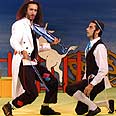
Paris celebrates Yiddish music
New exhibition in Paris looks at history of Yiddish music and theatre, highlighting central role of East European klezmer music
The exhibition was originally shown at the Paris Museum of Art and History of Judaism in 2000.
“Yiddish music ultimately has its roots in Jewish religion. It is an integral part of Jewish culture,” commented Gilles Rozier, the chairman of the House for Yiddish Culture.
“The Jewish love of music is seen in the earliest biblical stories,” he added.
Nicole Rosen, a member of the centre, agreed: “Yiddish culture has produced a variety of Jewish music. Lullabies, love songs, mournful songs of loss and exile and the wild klezmer music.”
Joy and despair
Yiddish music is most commonly associated with klezmer, Hebrew for “instruments of song.”
It was traditionally played on string instruments like fiddles and violas, the “tsimbl” (a Jewish instrument similar to a dulcimer) and flutes.
Klezmer music originated in the ghettos and “shtetls,” or villages, of Eastern Europe. The itinerant Jewish troubadours, known as “klezmorim”, performed at joyful events like weddings.
“Klezmer music expresses joy, despair, meditation, drunkenness, and, of course, love,” says Rosen.
Influences from Slav, Greek, Turkish, Arabic, gypsy music and later from American jazz transformed klezmer into a unique medley of sounds, which are easily recognisable and widely appreciated around the world.
Klezmer reached the United States in the mid-19th century, where figures like Dave Tarras, Naftule Brandwein and Abe Schwartz became famous musicians.
Celebrated jazz musicians like Sidney Bechet and Benny Goodman also drew inspiration from the klezmer sounds which later also spread to Western Europe.
Yiddish theatre
Yiddish culture also has a rich theatrical tradition, which is rooted in the group Broder Singers and traditional Purim festival plays.
However, it was the folk poet and singer Abraham Haim Lipke Goldfaden who developed the first professional Yiddish theatre, producing dozens of plays at the end of the 19th century.
Goldfaden’s theatre company travelled throughout Europe and later moved to New York City where the company opened a theatre.
Yiddish theatre can take on many forms and includes everything from operetta and musical comedy to satiric cabaret and modernist plays.
The House for Yiddish Culture works to preserve the Yiddish culture and make it accessible to a new generation.
The centre offers a wide variety of Yiddish activities including language classes, lectures and cookery courses.
The exhibition “Klezmer and Klezmorim: A Yiddisher Tam, a Yiddisher Tempo” runs until 21 April at the House for Yiddish Culture-Bibliotheque Medem, Passage Saint-Pierre Amelot 18, Paris. Tel. +33-1-4700-1400










